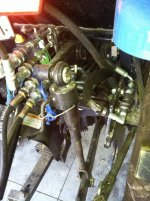sixdogs
Super Star Member
- Joined
- Dec 8, 2007
- Messages
- 15,704
- Location
- Ohio
- Tractor
- Kubota M7040, Kubota MX5100, Deere 790 TLB, Farmall Super C
There has been this discussion before since I have seen it but can't find it now in a search. I am rebuilding a simple drag harrow that needs a typical 3" by 8" cylinder for the lift function. In the past I have always used 1/2" hose because that's what I have always done before. The plan now is to use this with my Kubota L4300 that came with 3/8" NPT hose ends. So I already have those plus I have some 3/8" hose on hand that would work. I would simply use a 1/2' by 3/8' 90 degree adapter on the cylinder ends. If I used the 3/8" I would save around $50. I would primarily use my L4300 with this there may be a time when I use the cylinder on different equipment or a bigger tractor.
As I recall, smaller or larger hose has an impact on the cylinder behavior but I cannot recall exactly what that was. Any help on this?
As I recall, smaller or larger hose has an impact on the cylinder behavior but I cannot recall exactly what that was. Any help on this?

